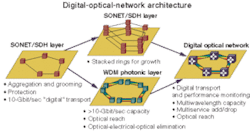Digital optical networks simplify architectures
The introduction of WDM into core networks has reduced bandwidth costs by more than 98% in the past decade and enabled significant growth in network traffic. Before the advent of WDM, optical transport required the use of digital repeaters along the network to regenerate optical signals degraded during transmission. These digital repeaters performed optical-electrical-optical (OEO) conversion of the optical signals so the digital data couldbe re-amplified, re-shaped, and re-timed (leading to the term "3R regeneration") and provided bandwidth management and performance monitoring at each site. The digital data would then be converted back into the optical domain, and the process would continue across the network.
The economic benefits of WDM derive from two key attributes. First, the technology provides the ability to significantly scale fiber capacity by multiplexing many optical channels along a single fiber. Second, WDM enables a significant reduction in the number and cost of OEO repeaters by replacing some of these with optical amplifiers to increase optical reach and amortize costs across many channels. In the process, however, digital access at repeater sites has been lost.
As a result, optical transport networks have become increasingly analog, relying on the amplification, manipulation, and management of analog wavelengths instead of digital bits. This trend has caused optical networks to lose their engineering simplicity-and gain new cost pressures. For example, the need to sustain "all-optical" transmission over extensive distances forces system designers to move from the simple plug and play engineering of digital SONET/SDH repeaters to more complex measurement, engineering, and adjustment of analog optical transmission systems. In addition, the need to compensate for optical transmission impairments requires many special compensation elements, increasing system first cost in the process. Finally, the manipulation of wavelengths instead of digital bits significantly decreases network flexibility for functions such as traffic add/drop, bandwidth management, network diagnostics, and service-level-agreement (SLA) management. The provision of these functions requires WDM terminals with costly OEO conversions, thus negating the economic benefits of WDM in the process.
In comparison, a digital optical network (DON) combines the capacity of WDM with the traffic management flexibility and engineering simplicity of digital transport systems. It also enables network cost savings through the use of large-scale photonic integration. The DON provides flexible access to the underlying digital data at any node for the purpose of add/drop, bandwidth management, performance monitoring, or other value-added manipulation. In the process of providing frequent cost-effective digital access, a DON reduces the analog optical portions of the network to allow plug and play operation and simplified network planning, engineering, installation, and operation.
Building the DON
The fundamental building block of a DON is the digital node, which provides high-capacity WDM optical transport and digital add/drop flexibility. The digital node uses photonic-IC technology (see Figure 1) to provide ultra-low-cost OEO access to the WDM bandwidth, allowing the optical signals to be converted into the electronic domain for value-added manipulation using silicon electronics and software, before conversion back into optics (see Figure 2). Optical bandwidth transiting through a digital node can therefore be easily managed to maximize service flexibility and simplify network engineering and operations.
Digital-signal cleanup and performance monitoring provided through frequent access to digital-wrapper or SONET/SDH overhead provide valuable information on service level agreements and network performance and enables faster and more accurate fault identification and troubleshooting. Value-added system software automates system turn-up, adjustment, and operation and significantly simplifies all aspects of ongoing system operations.
Digital multiplexing, grooming, and add/drop capabilities enable sub-wavelength bandwidth management at each node. This ability reduces the need for external bandwidth management within the core of the network and allows both line-side and client-side traffic to be added/dropped, multiplexed, groomed, or protected. A digital node can be equipped with a wide range of SONET, SDH, Ethernet, or SAN service interfaces for connection to new and existing customers. Finally, the application of a Generalized MPLS control plane enables automated end-to-end service provisioning and topology auto-discovery and provides a service platform for enabling the introduction of intelligent optical networks.
The features, flexibility, and cost-effectiveness of a digital node enable the use of a common system platform across metro, regional, long-haul (LH), and ultra-long-haul (ULH) networks. Thus, a DON can be implemented by deploying digital nodes anywhere carriers desire to provide "on-net" access to their networks. These nodes can then be interconnected in abuilding-block fashion using simple-to-engineer digital links, in which optical line amplifiers can extend the optical reach between digital nodes. DONs can be implemented incrementally where required due to capacity exhaust or geographical expansion to reduce network cost. A carrier can also extend a DON to accommodate network growth or cost-effectively increase the number of add/drop sites in the network, thereby extending the carrier's on-net presence into new markets.
Network benefits
DONs allow carriers to significantly reduce the capital and operating costs of their networks. They offer simplified architectures, consolidated transport and bandwidth management, flexible add/drop, end-to-end service management, and maximized network revenue potential.
DONs also enable carriers to avoid the compromise that existing WDM systems impose between minimal network cost and maximum customer access. With traditional WDM, a regional or "collector" network is deployed to maximize on-net access in target markets, while an overlay ULH or "express" network is deployed only at major cities to lower OEO cost for end-to-end circuits. Finally, separate metro WDM systems are often deployed to connect carrier central offices, data centers, and carrier hotels in large metropolitan areas. Such network architectures, although a justifiable compromise given today's WDM technology options, impose capital and operating costs while increasing network complexity. By comparison, a DON can be cost-effectively deployed to address the needs of frequent network access along high-density regional routes, LH transport on express routes, and metro core connectivity requirements. That reduces backhaul traffic between collector and express networks and reduces the cost and complexity of using optical crossconnects to manage capacity at junction nodes.
Leveraging low-cost OEO access at each node, a DON provides flexible sub-wavelength bandwidth management within the optical transport layer and eliminates the point-to-point and back-to-back architectures of typical WDM systems. The ubiquitous digital access at each digital node extends the flexibility to add and drop customer traffic where and when required without extensive pre-planning or reconfiguration. Combined with a Generalized MPLS control plane, that enables point-and-click end-to-end service management and allows carriers to easily turn up transport capacity between any digital nodes within the network, irrespective of topology.
A DON therefore simplifies nodal architecture by consolidating digital transport, flexible multiservice add/drop, and multiwavelength capacity into a common core network. That allows carriers to manage the high-capacity circuits within a single DON layer and complements the capabilities of local SONET/SDH and data service platforms that provide aggregation and grooming at the edges of the network (see Figure 3). Finally, use of a common DON deployed for metro core, regional, and LH applications reduces the number of system technologies, simplifies network engineering, and reduces operational costs for installation, sparing, training, documentation, space allocation, power consumption, network management, and maintenance.
The cost-effective deployment of a DON anywhere customer access is required in the network enables carriers to lower the business-case threshold required to connect customers, thus increasing potential revenues. In contrast, with today's WDM technology, carriers face the dilemma of either minimizing network cost by minimizing OEOs (and thus the number of add/drop sites) or maximizing customer revenue, but not both. A DON eliminates the need to make such a compromise.
Leveraging the low-cost add/drop of a DON, carriers can deploy digital nodes more frequently in their networks to provide service in more markets, including secondary markets that may previously have been bypassed. By increasing the on-net footprint of their networks, carriers can derive several important benefits:
- Extend network connectivity to customers with geographically extensive service requirements.
- Increase addressable market by providing on-net access in under-served markets or those with a historically limited choice of service providers.
- Maximize revenue capture from their network to increase top-line growth.
- Increase margins by reducing reliance on leased backhaul circuits.
- Improve price competitiveness by reducing the cost of on-net access.
- Increase service offerings with lower-bit-rate services where previously only wholesale wavelength services might have been justified.
- Maximize service responsiveness to new demands, changing customer connectivity, or new service -requirements.
Carriers facing the span-by-span capacity exhaust of legacy WDM systems can begin deployment of a DON on these portions of the network to gain immediate capital-expenditure savings and subsequently extend the DON architecture to more fundamentally re-shape their network economics and architecture. For carriers planning geographical network expansions or overbuilds, a DON can be seamlessly integrated with existing SONET/SDH and WDM systems to allow carriers to transition from an operational-cost structure burdened by legacy WDM systems. Finally, carriers seeking to evolve their network architecture and service offerings in response to changing market conditions can deploy a DON to maximize their market presence and service competitiveness to meet today's and tomorrow's market requirements.
Serge Melle is vice president of account marketing and network architecture at Infinera (Sunnyvale, CA), responsible for market development, technical customer support, and network-architecture strategy. He can be reached at [email protected].



